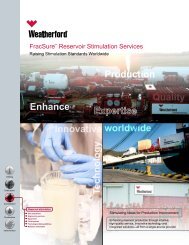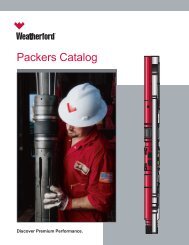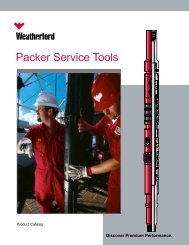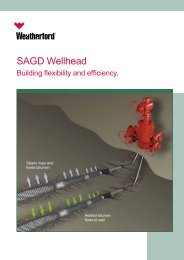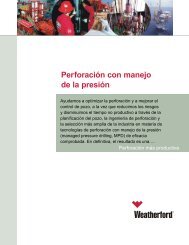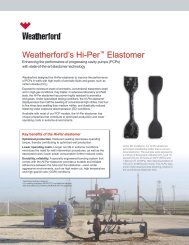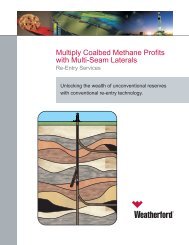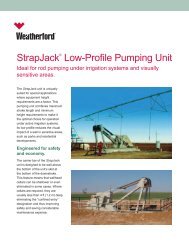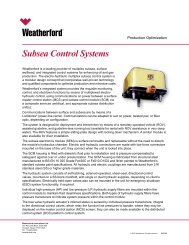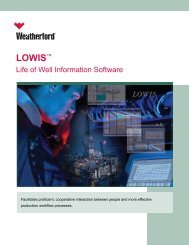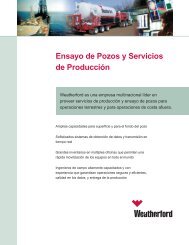MetalSkin - Weatherford International
MetalSkin - Weatherford International
MetalSkin - Weatherford International
Create successful ePaper yourself
Turn your PDF publications into a flip-book with our unique Google optimized e-Paper software.
ouble<br />
one<br />
Current<br />
production<br />
7 in.<br />
Target<br />
zone<br />
Application Answers<br />
Accessing Deeper<br />
Reserves<br />
<strong>MetalSkin</strong> ®<br />
<strong>MetalSkin</strong> Monobore Open-Hole Clad<br />
<strong>MetalSkin</strong> Cased- and Open-Hole<br />
Liner and Monobore Open-Hole Clad Systems<br />
Challenge<br />
Enhanced exploration techniques are identifying<br />
deeper horizons, many of which underlie existing<br />
field developments. As wells deplete and fields<br />
mature, operators consider using existing wells to<br />
develop these new reserves to prolong the life of<br />
the wells, the field, and the facilities. The challenge<br />
is to perform these operations, either by deepening<br />
or by plugging back and sidetracking the existing<br />
wells, in such a way as to maintain sufficient<br />
hole size to facilitate subsequent completion,<br />
stimulation, and production operations. Standard<br />
methods of lining the deepened well—to complete<br />
and produce the newly opened zones—result in<br />
a greatly reduced ID. This reduced ID can inhibit<br />
production capacity and impede well access.<br />
13-3/8 in.<br />
9 5/8-in.<br />
9 5/8-in.<br />
13-3/8 in.<br />
5 in. 7 in.<br />
Current<br />
production<br />
7 5/8- × 9 5/8-in.<br />
Target<br />
zone<br />
Answer<br />
Cased- and Open-Hole Liner and<br />
Monobore Open-Hole Clad Systems<br />
<strong>MetalSkin</strong> Cased-Hole Liner<br />
<strong>MetalSkin</strong> Open-Hole Liner<br />
<strong>Weatherford</strong>’s <strong>MetalSkin</strong> open-hole and cased-hole<br />
liner systems are designed to deal with welldeepening<br />
drilling challenges, while the monobore<br />
open-hole clad system can be used to seal off<br />
old production and problem zones. Metal Skin<br />
solid-expandable systems facilitate the redrilling<br />
of mature wells, thereby enhancing their long-term<br />
production capabilities. These systems can be<br />
used to line the redrilled section with no loss in<br />
hole size. The <strong>MetalSkin</strong> system can be expanded<br />
in place to isolate problem zones or provide well<br />
integrity over the full length of the redrilled section,<br />
as required for subsequent production and/or<br />
remediation operations.<br />
<strong>MetalSkin</strong> systems economically<br />
deepen mature production wells<br />
to access new reserves.<br />
Trouble<br />
zone<br />
© 2009 <strong>Weatherford</strong>. All rights reserved.
Current<br />
production<br />
Trouble<br />
zone<br />
Target<br />
zone<br />
Base Case<br />
Existing Condition in Mature Well<br />
13-3/8 in.<br />
9-5/8 in.<br />
The current producing zone in a cased and perforated well<br />
has been depleted. The well will be reentered to access<br />
reserves from a deeper target zone. Above this new zone,<br />
a trouble zone is expected, which will require isolation<br />
before drilling into the new target zone.<br />
2<br />
Current<br />
production<br />
Trouble<br />
zone<br />
Target<br />
zone<br />
<strong>MetalSkin</strong> ®<br />
Cased- and Open-Hole Liner and<br />
Monobore Open-Hole Clad Systems<br />
Conventional Deepening<br />
13-3/8 in.<br />
9-5/8 in.<br />
7 in.<br />
5 in.<br />
A cement squeeze isolates the depleted production zone.<br />
The existing 9 5/8-in. shoe is drilled out in the 8 1/2-in. hole<br />
through the trouble zone. This zone is isolated with a 7-in.<br />
cemented liner, tied back above the current production zone.<br />
The deeper target zone is then drilled in a 6 1/8-in. hole and<br />
cased with a 5- or 5 1/2-in. liner, depending on burst and<br />
collapse requirements.<br />
© 2009 <strong>Weatherford</strong>. All rights reserved.
Current<br />
production<br />
Trouble<br />
zone<br />
Target<br />
zone<br />
Expandable Approach – Option 1<br />
13-3/8 in.<br />
13-3/8 in.<br />
9-5/8 in. 9-5/8 in.<br />
7 in.<br />
5 in.<br />
7 5/8- × 9 5/8-in.<br />
cased-hole liner<br />
8-1/2 in. monobore<br />
open-hole clad<br />
Current<br />
production<br />
Trouble<br />
zone<br />
Target<br />
zone<br />
13-3/8 in.<br />
5 in. 7 in.<br />
5 in.<br />
If a cement squeeze job is not sufficient to effectively isolate<br />
the depleted (current) zone, then a 7 5/8- × 9 5/8-in. casedhole<br />
liner can be installed over the existing perforations.<br />
Subsequently, instead of running a conventional cemented liner<br />
to isolate the trouble zone, an 8 1/2-in. monobore open-hole<br />
clad is set. This liner temporarily isolates the trouble zone with<br />
no loss of hole size, enabling the target zone to be drilled in the<br />
8 1/2-in. hole. Because the hole size has been saved, it is now<br />
possible to run conventional 7-in. flush-joint casing across the<br />
trouble zone and the new producing interval, and tie this casing<br />
back above the old cement-squeezed interval. When compared<br />
with a conventional approach, this application of an expandable<br />
liner gives a higher productivity index because of the increased<br />
hole size.<br />
3<br />
<strong>MetalSkin</strong> ®<br />
Cased- and Open-Hole Liner and<br />
Monobore Open-Hole Clad Systems<br />
Expandable Approach – Option 2<br />
Conventional Expandable Conventional Expandable<br />
13-3/8 in.<br />
9-5/8 in. 9-5/8 in.<br />
7 in.<br />
8-1/2 in. monobore<br />
open-hole clad<br />
7 5/8- × 9 5/8-in. <strong>MetalSkin</strong><br />
open-hole liner<br />
The production potential of the well can be even further<br />
increased by replacing the 7-in. conventional liner across the<br />
new target zone with a 7 5/8- × 9 5/8-in. open-hole liner. This<br />
liner can again be tied back above the old producing interval,<br />
as well as permanently casing the trouble zone. This approach<br />
then equates to a further increase in the ID through the new<br />
reservoir section from just over 4 in. in the conventional<br />
approach to 7 in. with this open-hole liner approach.<br />
© 2009 <strong>Weatherford</strong>. All rights reserved.
Current<br />
production<br />
Trouble<br />
zone<br />
Target<br />
zone<br />
7 in.<br />
5 in.<br />
Sidetrack – Option 3<br />
Conventional Sidetrack Expandable Sidetrack<br />
13-3/8 in.<br />
9 5/8-in.<br />
9 5/8-in.<br />
13-3/8 in.<br />
4<br />
7 in.<br />
<strong>MetalSkin</strong> ®<br />
Current<br />
production<br />
Trouble<br />
zone<br />
7 5/8- × 9 5/8-in.<br />
Cased- and Open-Hole Liner and<br />
Monobore Open-Hole Clad Systems<br />
Target<br />
zone<br />
If the well must be sidetracked to a new reservoir location, rather than simply deepened, the loss<br />
of hole size associated with conventional casing programs can impede completion objectives.<br />
A conventional approach for a sidetrack in an 8 1/2-in. open hole out of the existing 9 5/8-in.<br />
casing results in a 7-in. cemented casing across the trouble zone and a 5-in. liner in the new<br />
reservoir section. Isolating the trouble zone with a 7 5/8- × 9 5/8-in. open-hole expandable liner<br />
enables 7-in. flush-joint casing to set in the existing 9 5/8-in. casing and set at the target total<br />
depth (TD).<br />
© 2009 <strong>Weatherford</strong>. All rights reserved.
Constraints<br />
There are two standard options to work over<br />
existing wells when accessing deeper reserves:<br />
• The well can be reentered as is and drilled out to<br />
reach the deeper horizon.<br />
• The mature well can be plugged back and then<br />
sidetracked to access the deeper reserves.<br />
In either case, some limitations inevitably occur<br />
using conventional methods, which can lead to<br />
a reduction in hole size when entering the new<br />
formation of interest. Whether deepened or<br />
sidetracked, drilling must take place through the<br />
original producing formation, which is probably<br />
depleted; therefore, lost-circulation conditions that<br />
will require remediation can be expected. These<br />
conditions can be treated conventionally by:<br />
• Squeeze cementing of the previous producing<br />
zone before deepening the well. This approach<br />
runs the risk of breakdown during drilling<br />
operations and may require costly and timeconsuming<br />
squeeze operations.<br />
• A conventional liner or scab liner can be used,<br />
resulting in a significant loss of hole size.<br />
• If lost circulation occurs in the “old” zone of a<br />
sidetracked well, setting a liner may be required,<br />
thus causing a loss of hole size.<br />
Another option is that the redrilled well be<br />
completed in open hole; however, the production<br />
control and isolation problems associated with<br />
open hole are inevitable. Scab liners can ultimately<br />
be used to isolate any problem zones, but again,<br />
the resultant loss of hole size can be critical to<br />
production operations.<br />
5<br />
<strong>MetalSkin</strong> ®<br />
Cased- and Open-Hole Liner and<br />
Monobore Open-Hole Clad Systems<br />
Features, Advantages and Benefits<br />
• <strong>MetalSkin</strong> solid-expandable cased-hole or openhole<br />
liner systems, together with monobore openhole<br />
clad systems, as appropriate, can be used<br />
to address the shortcomings of conventional<br />
solutions. These systems can provide a proven<br />
and effective method of casing the worked-over<br />
or redrilled well with minimal or no loss of hole<br />
size, thereby greatly improving production, while<br />
at the same time addressing future well access<br />
concerns.<br />
• The threaded expandable tubular joints of the<br />
cased-hole liner system can be connected to<br />
create a lengthy liner. Alternatively, a single<br />
length of open-hole clad can be used, or several<br />
short sections of open-hole clad can be run<br />
to straddle trouble spots in the open hole, as<br />
needed.<br />
• The elastomeric seal elements, strategically<br />
placed along the length of the liner, provide<br />
additional effective zonal isolation in either<br />
cased-hole or open-hole applications.<br />
• The loss of ID can be minimized by using either<br />
the cased-hole liner or the open-hole liner<br />
system. If a suitable seat can be found below the<br />
casing shoe, then the monobore open-hole clad<br />
system can be used to retain the same ID. In<br />
either case, the <strong>MetalSkin</strong> system can maximize<br />
production or injection capacity.<br />
• No matter which <strong>MetalSkin</strong> system is used, the<br />
resultant ID is greater than that obtainable with<br />
conventional equipment. This larger ID enables<br />
better access to the well and to the use of<br />
conventional tools in subsequent completion or<br />
remedial operations.<br />
• The <strong>MetalSkin</strong> cased-hole system provides<br />
superior efficiency and economy and, unlike<br />
other expandable and conventional systems,<br />
requires no drillout.<br />
• The well can still be deepened, if required, by<br />
drilling through the <strong>MetalSkin</strong> cased-hole liner<br />
after it has been set.<br />
© 2009 <strong>Weatherford</strong>. All rights reserved.
<strong>Weatherford</strong> <strong>International</strong> Ltd.<br />
515 Post Oak Blvd., Suite 600<br />
Houston, Texas 77027 USA<br />
Tel: 713-693-4000<br />
weatherford.com<br />
<strong>MetalSkin</strong> ®<br />
Cased- and Open-Hole Liner and<br />
Monobore Open-Hole Clad Systems<br />
Learn more about the <strong>MetalSkin</strong> cased- and open-hole liner systems, as well as<br />
the <strong>MetalSkin</strong> monobore open-hole clad system—all part of the <strong>MetalSkin</strong> family of<br />
new-generation, solid-expandable technologies—and how they can deal with the<br />
challenges of reworking an existing mature well by whatever means to access a<br />
deeper zone of interest.<br />
Contact the world’s most experienced expandable experts, with the most advanced<br />
line of products, through your local <strong>Weatherford</strong> representative, or visit us at<br />
weatherford.com/metalskin.<br />
The Solid Choice TM<br />
from the expandable experts<br />
<strong>Weatherford</strong> products and services are subject to the Company’s standard terms and conditions, available<br />
on request or at weatherford.com. For more information contact an authorized <strong>Weatherford</strong> representative.<br />
Unless noted otherwise, trademarks and service marks herein are the property of <strong>Weatherford</strong>. Specifications<br />
are subject to change without notice. <strong>Weatherford</strong> sells its products and services in accordance with the<br />
terms and conditions set forth in the applicable contract between <strong>Weatherford</strong> and the client.<br />
© 2009 <strong>Weatherford</strong>. All rights reserved. 4751.00



